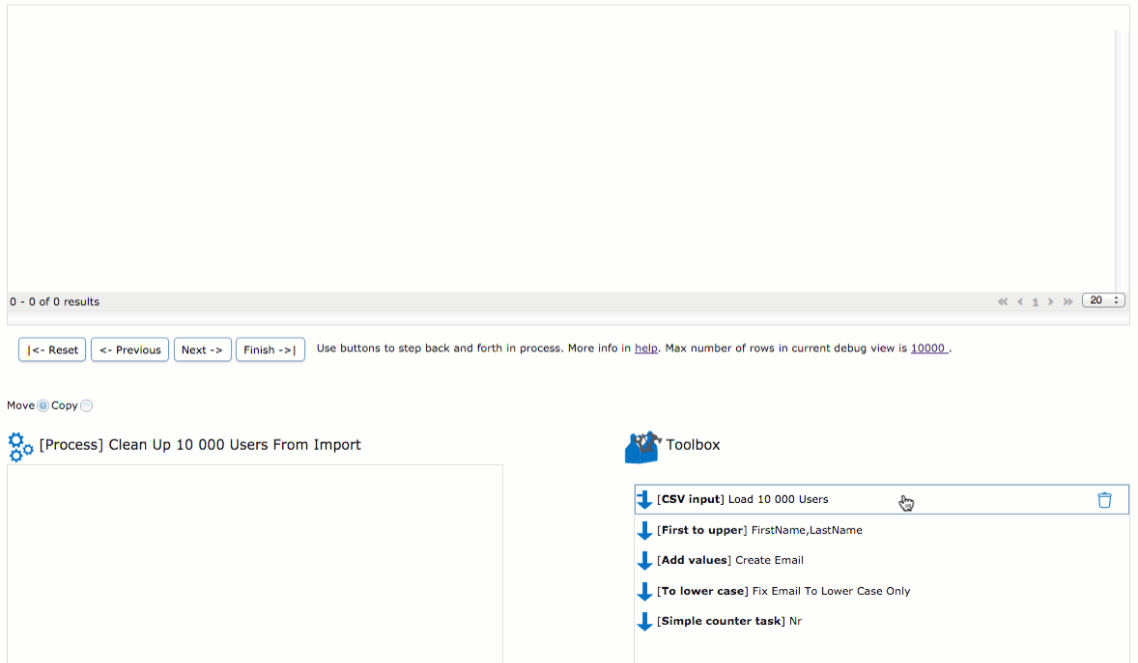DataMinder: How it works!
Rapid Server Development
| WHAT IS DATAMINDER? |
WHY SHOULD WE USE IT? |
HOW DOES IT WORK? |
| DataMinder Server allows you to develop, combine and reuse modules to build enterprise applications quickly. |
Aimed at professionals working with any corporate data. You'll be able to focus on the solution, not the tools. |
It's simple to use. Build, deploy and monitor new enterprise solutions quickly and easily. With reusable Java plugins. |

Decide what to do?
What needs to be done? What steps do you do? Which flows do you need to implement?



Design and build the missing plugins in no time!
Build Tasks, Inputs, Outputs, Decisions, Services, Listeners, Schedulers or Common Objects.
Generate code or checkout our samples here!
Write your code -> Put in a Jar file -> Install Jar file -> DnD to build your flow!
//The run method where you put implementation
run(tableWithData, pluginParameters)
{
}
* And yes, you can debug your plugin directly in DataMinder. Run your code, step by step. Do the fun stuff and let DM do the boring stuff!
Have all the plugins? Go to  |

Which plugins do you need to build the solution?
-
 Tasks
Tasks manipulate data
send mail, set data to lower case, encrypt data etc.
-
 Inputs
Inputs get data
read a file, retrieve data from database etc.
-
 Outputs
Outputs output data
write data to file, write data to database etc.
-
 Decisions
Decisions change the flow
include another process, redirect flow to another process, check authentication etc.
-
 Services
Services listen to outside events
http/https web service calls, file modifications etc.
-
 Listeners
Listeners start a process when a service receives events
web service call, file is uploaded etc.
-
 Schedulers
Schedulers start a process based on time
every hour, every Sunday at 04:00 etc.
-
 Common Objects
Common Objects shared resources
database connections etc.
Do you have all plugins?
| YES! |
NO! |
Go to  |
Go to  |

Build your solution with DnD


Not advanced enough for you needs?
Well, let's say you have PLUGINS that do the following:
- Connection to databases like Microsoft SQL Server, Oracle, IBM DB2 or MySql.
- LDAP-connections to servers like Microsoft Active Directory. Find inactive users (which are a security risk) or licences for software no longer used (but still costing money).
- Read data from XML, CSV or JSON files when they are uploaded or modified.
- Send messages like email, SMS or chat when events occur.
- Integrate two different systems (having different API:s). Create on singel view from one or more different systems.
- Start processes based on SQL-trigger activation or when data is modified.
- Monitor systems to make sure they work.
- Verify replication between different data sources.
- Get access to thousands of external commands from Linux or Windows. Run Windows Powershell to connect to a Windows server.
- Schedule processes to be run every 10:th minute or 23:30 every last day in every month.
- Connect to GIS (Graphic Information System) services.
- Integrate and merge data from different data sources (database, LDAP ...) or responses from multiple services or servers. Present it as a single coherent view possibly accessible as a number of microservices.
- Connect DataMinder to public data sources like government, health or traffic data.
- Build test and build flows for software release.
- Connect DataMinder to payment solutions like PayPal.
- Build web and microservices with HTTP/HTTPS and JSON.
- Activate processes based on filsystem changes. When files or folders are created, modified or removed.
- Integrate with cloud solutions for image analysis, data storage or AI.
- ...
Or you have PLUGINS that do this:
- Make sure data in different data sources contains the same data format. No starting or ending spaces. Names using correct case. Phone numbers with the right format e.g. international.
- Create passwords, random numbers when new data is created like users.
- Use regular expressions for advanced searches or text manipulation.
- Automatically create new data based on previous data like email addresses from first and last names.
- Create flows to be initialized from a single microservices call.
- Cache data from external systems to enhance performance.
- Encrypt data, transform it to and from Base64, create signatures with SHA-256 or MD5.
- Merge data from multiple data sources and present it as a single data source.
- Return data that differs in data sources to remove unused user accounts or software licenses.
- Transform data from and to XML, HTTP parameters, configuration files or JSON.
- Create advanced flows with decision plugins, which call processes or terminate tasks.
- Create authentication and authorization solutions to allow access to systems.
- Wrap other software libraries to allow easy management with drag'n dropp.
- Find erroneous data or unused data like users, access permissions or unused licences.
- Load balance instances in the cloud with Docker or Kubernetes containers.
- ...
What kind of smart solutions could YOU build
with the plugins above?







